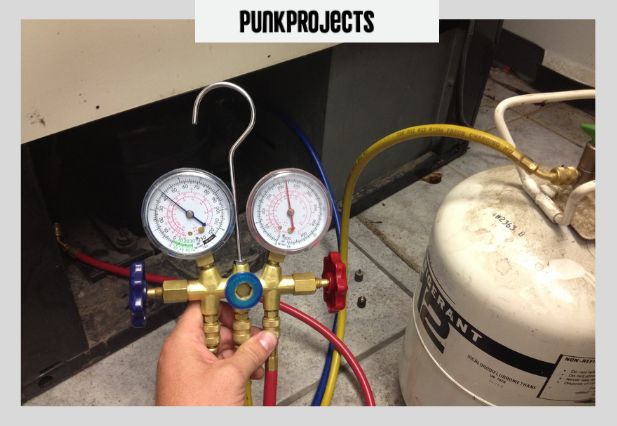It can be quite worrisome when your Kitchenaid Refrigerator not cooling, especially when it comes to preserving food and maintaining convenience in your kitchen.
If you’re facing the issue of a KitchenAid refrigerator not cooling, don’t panic! This troubleshooting guide is here to assist you in identifying the problem and finding solutions to get your KitchenAid refrigerator back to its optimal cooling performance.

Common Causes of a KitchenAid Refrigerator Not Cooling:
- Faulty Thermostat or Temperature Control:
Sometimes, a malfunctioning thermostat can disrupt the cooling cycle, preventing your refrigerator not cooling from reaching the desired temperature. - Dirty Condenser Coils:
Dust and debris build-up on the condenser coils can impede the release of heat, leading to inadequate cooling. - Malfunctioning Evaporator Fan:
The evaporator fan is responsible for circulating cool air throughout the refrigerator. If it’s not functioning properly, your fridge won’t cool as it should. - Blocked Vents or Air Circulation Issues:
Vents that are blocked or obstructed can disrupt the airflow, causing uneven cooling or a complete loss of cooling in certain areas. - Defective Compressor:
The compressor plays a crucial role in the refrigeration system. When it malfunctions, your refrigerator won’t be able to cool effectively. - Refrigerant Leakage:
Refrigerant leakage results in a decrease in refrigerant levels, leading to insufficient cooling. This issue requires professional attention to repair and recharge the system. - Power Supply Problems:
Sometimes, a disrupted power supply, like a tripped circuit breaker or a faulty outlet, can prevent your refrigerator from cooling properly.
Step-by-Step Troubleshooting Process:

- Check the Power Supply:
Begin by ensuring that your refrigerator is properly plugged in and that the power source is functioning correctly. Examine the circuit breaker or fuse box to rule out any power supply issues. - Examine the Thermostat and Temperature Controls:
Verify that the thermostat settings are appropriate for your desired cooling level. If needed, adjust the settings accordingly. Test the thermostat for functionality, or consider replacing it if it seems to be faulty. - Clean the Condenser Coils:
First, disconnect your refrigerator from the power source. Locate the condenser coils, usually found at the back or underneath the unit. Gently clean the coils using a vacuum or a brush to remove any accumulated dust and debris. - Inspect the Evaporator Fan:
Open your refrigerator and locate the evaporator fan. Ensure that it’s running smoothly and check for any obstructions. If the fan isn’t working, it may need to be replaced. - Unblock Vents and Ensure Proper Air Circulation:
Take a look inside your refrigerator for any items obstructing the vents. Clear away any blockages and ensure proper airflow throughout the unit. - Evaluate the Compressor:
Listen for any unusual noises coming from the compressor. If it’s not running or if you suspect it’s faulty, it’s best to consult a professional technician for a thorough assessment and potential repair or replacement. - Address Refrigerant Leakage:
If you suspect a refrigerant leak, it’s crucial to contact a qualified technician who can diagnose and repair the issue. Refrigerant handling requires specialized knowledge and equipment.
Additional Tips and Precautions:
- Perform regular maintenance, including cleaning your refrigerator and checking for any signs of wear or damage.
- Consult your refrigerator’s user manual or reach out to KitchenAid’s customer support for specific troubleshooting advice or warranty coverage.
- If the troubleshooting steps don’t resolve the cooling problem, consider contacting a professional
Kitchenaid Refrigerator Reset Button

If you’re looking to reset your KitchenAid refrigerator, there isn’t a specific button for that. However, you can try a power reset, which can help with some common issues. Here’s what you can do:
- Find the power cord of your KitchenAid refrigerator. It’s usually at the back near the bottom.
- Unplug the refrigerator from the wall outlet. Just pull the plug gently to disconnect it.
- Leave it unplugged for about 5 minutes. This gives the refrigerator a chance to reset itself.
- While it’s unplugged, take a moment to clean the coils at the back of the fridge. If you see any dust or debris, gently remove it. This helps with better cooling.
- After the 5 minutes are up, plug the refrigerator back into the outlet.
- Wait for a few minutes to let it restart and get back to normal.
This simple power reset can often fix small issues and get your KitchenAid refrigerator working again. However, if you’re still having problems or seeing error codes, it’s best to consult the user manual or reach out to KitchenAid’s customer support for further assistance. They’ll be able to provide you with more specific guidance based on your situation.
Kitchenaid Refrigerator Compressor Not Running

If you’re noticing that the compressor in your KitchenAid refrigerator isn’t running, it could mean there’s a problem with the cooling system. Here are some simple steps to troubleshoot the issue:
- Check the power supply and ensure it’s properly plugged in.
- Verify the temperature settings inside the refrigerator.
- Clean the condenser coils to prevent overheating.
- Check the start relay and have it replaced if necessary.
- Contact KitchenAid’s customer support or a technician for further assistance if the issue persists.
Remember, dealing with electrical components can be risky, so if you’re not comfortable with appliance repairs, it’s always safer to get help from a professional. They can ensure your safety and prevent further damage to the refrigerator.
Kitchenaid Refrigerator Problems Temperature

If you’re having problems with the temperature in your KitchenAid refrigerator, here are a few simple things to check:
- Check the temperature settings inside the refrigerator and adjust if needed.
- Make sure the door seals are clean and sealing properly.
- Clean the condenser coils at the back or bottom of the refrigerator.
- Ensure that the air vents inside the refrigerator are not blocked.
- Check for any power outages or interruptions.
- If the issues persist, contact KitchenAid’s customer support or a professional technician for further assistance.
Remember, proper food storage is important, so if you have concerns about perishable items, it’s best to discard them to avoid any health risks.
How to Turn Cooling on Kitchenaid Refrigerator
To turn on the cooling in your KitchenAid refrigerator, follow these simple steps:
- Look for the temperature control panel or dial inside the fridge.
- If you have a digital panel, press the “Power” or “On/Off” button to start the cooling.
- If you have a temperature dial, turn it to a suitable cooling setting.
- Give the refrigerator a few minutes to start cooling.
- Listen for the sound of the compressor running and feel for cold air coming from the vents.
If you have any trouble, consult the user manual or reach out to KitchenAid’s customer support for assistance.
Frequency Ask Question
Why isn’t my KitchenAid refrigerator cooling?
If your KitchenAid refrigerator isn’t cooling, there are a few possible reasons. It could be due to incorrect temperature settings, a faulty compressor, blocked air vents, dirty coils, or a malfunctioning thermostat.
How can I troubleshoot my KitchenAid refrigerator not cooling?
First, check the temperature settings to make sure they’re set correctly. Clean the coils to remove dirt and debris. Ensure that the air vents inside the fridge are not blocked. Listen for the sound of the compressor running. If the problem persists, contact KitchenAid’s customer support or a technician for further help.
What should I do if my KitchenAid refrigerator isn’t cooling properly?
Adjust the temperature settings, ensure proper airflow, and clean the coils. If the problem continues, reach out to KitchenAid’s customer support or a technician to diagnose and fix the issue.
Why is only a specific area of my KitchenAid refrigerator not cooling?
If a specific area isn’t cooling, it may be due to blocked vents or a problem with temperature control in that section. Check for obstructions and make sure there’s proper airflow. If the problem persists, seek professional assistance.
How can I prevent future cooling issues with my KitchenAid refrigerator?
Clean the coils regularly, maintain proper temperature settings, avoid overloading the fridge, and ensure the door seals are intact. Consider scheduling regular maintenance and cleaning to prevent cooling problems in the future.
I am a multi-talented designer and contractor with over 10 years of experience in the field. I have a passion for creating beautiful, innovative spaces that reflect my clients’ needs and styles. My skills include architectural design, interior design, space planning, project management and construction supervision.






